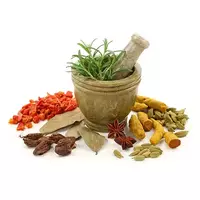Spices

It is no secret that well-chosen seasonings, spices and spices can significantly improve the taste, as well as the aroma of a culinary product. In addition, many types of spices have truly healing properties. It is for this reason that humanity has long been using various flavors, including spices, when preparing food. Spices are none other than components of plants, which are used in small dosages when preparing food.
The main purpose of spices, as well as other flavors, is to improve or adjust the taste, as well as the aroma of finished culinary products. It is noteworthy that spices include exclusively flavors of plant origin. Since our Mother Nature has created an incredible number of different plants, hundreds of different kinds of spices are currently used in cooking. Interestingly, people began to eat spices long before salt and other famous spices and seasonings were discovered.
The first documentary references to various types of spices were dated to 3000 BC. Cinnamon is considered one of the first popular spices. The distinctive properties of the spice are so firmly established in the culture of the inhabitants of the Ancient World that statements of noble Romans about exorbitant waste associated with exotic spices have been preserved. It is truly unique that a variety of classical spices played an important role in the economy and social structure of medieval society. Nowadays, the main suppliers of spices are countries such as India, Bangladesh and Turkey.
Types of spices
The following most popular and common spices can be distinguished: asafetida, vanilla, cloves, ginger, cardamom, cinnamon, turmeric, bay leaf, nutmeg, various types of peppers (black, white, red, chili, cayenne, jalapeño, etc. ), rosemary, lime zest, lemon, orange and other citrus fruits, as well as saffron. In addition, such spicy vegetables as: onions (bulb, juxai, leek, shallot, lettuce and others), garlic, wild garlic are distinguished in a separate group.
Spicy root crops are also distinguished - horseradish, fennel, parsnips, parsley, celery. However, even the spices listed above are just the tip of the iceberg, since each national culinary tradition has its own special flavors. In addition, a large number of herbs also belong to spices. For example, anise, basil, zira, cumin, kmin, various types of mustard, as well as balm, marjoram, mint, wormwood, dill, thyme and many others. Especially popular are the original spicy mixtures, which include a perfectly selected ground mass of various spices and herbs.
Among the most famous spicy mixtures are Indian mixtures and curries, Chinese mixtures, hop-suneli, dolma or ajika, as well as a bouquet of garni, Hamburg or Bologna mixtures. It is worth emphasizing that spices are used not only to bring new shades of taste or aroma to the culinary product. Some spices help to preserve the distinctive taste and consumer qualities of the products, and also gives the culinary product the necessary consistency.
The benefits of spices
Moreover, there is a huge benefit of spices for the human body. Even in ancient times, people noticed that some spices have beneficial properties. The benefits of spices lie in the chemical composition of the plant material, from which spices are subsequently made. For making spices, leaves, root crops and roots are used, as well as stems, fruits, inflorescences, bark, as well as peel of plants, the chemical composition of which is enriched with various vitamins and useful compounds of natural origin.
spices 247 kCal
Energy value of spices (Ratio of proteins, fats, carbohydrates - ju):
Squirrels: 3.99 g (~ 16 kCal)
Fats: 1.24 g (~ 11 kCal)
Carbohydrates: 27.49 g (~ 110 kCal)
Energy ratio (bj | y): 6% | 5% | 45%
 Español
Español Français
Français Português
Português Русский
Русский 简体中文
简体中文 繁體中文
繁體中文 日本語
日本語 한국어
한국어 العربية
العربية Türkçe
Türkçe Қазақ
Қазақ Deutsch
Deutsch Italiano
Italiano Українська
Українська
